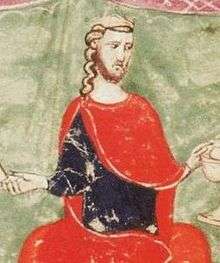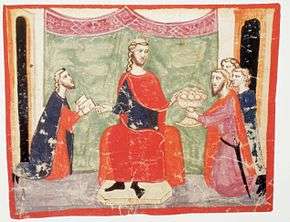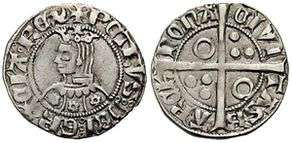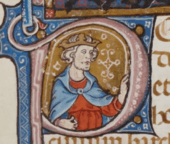Peter III of Aragon
| Peter III | |
|---|---|
 | |
| King of Aragon and Valencia Count of Barcelona | |
| Reign | 27 July 1276 – 11 November 1285 |
| Coronation | November 1276 (Zaragoza) |
| Predecessor | James I |
| Successor | Alfonso III |
| King of Sicily | |
| Reign | 4 September 1282 – 11 November 1285 |
| Coronation | 9 November 1282 (Palermo) |
| Predecessor | Charles I |
| Successor | James II |
| Born |
c. 1239 Valencia |
| Died |
11 November 1285 (aged 45–46) Vilafranca del Penedès |
| Burial | Santes Creus |
| Consort | Constance of Sicily |
| Issue |
Alfonso III, King of Aragon James II, King of Aragon Elisabeth, Queen of Portugal Frederick II, King of Sicily Yolanda, Duchess of Calabria |
| House | House of Barcelona |
| Father | James I of Aragon |
| Mother | Violant of Hungary |
| Religion | Roman Catholicism |
Peter the Great (Catalan: Pere el Gran, Aragonese: Pero lo Gran; 1239 – 11 November 1285)[1] was the King of Aragon (as Peter III) of Valencia (as Peter I), and Count of Barcelona (as Peter II) from 1276 to his death, (this union of kingdoms was called the Crown of Aragon). At the invitation of some rebels, he conquered Sicily and became its king in 1282, pressing the claim of his wife, Constance of Hohenstaufen, uniting the kingdom to the crown. He was one of the greatest of medieval Aragonese monarchs.
Youth and succession
Peter was the eldest son of James I of Aragon and his second wife Violant of Hungary. Among (opportunistic) betrothals of his youth, he was betrothed to Eudoxia Laskarina, the youngest daughter of Emperor Theodoros II of Nicaea, in or before 1260. This contract was dissolved, however, after Eudoxia's brother lost the imperial throne in 1261, and Eudoxia was instead married to the Count of Tenda. On 13 June 1262, Peter married Constance, daughter and heiress of Manfred of Sicily. During his youth and early adulthood, Peter gained a great deal of military experience in his father's wars of the Reconquista against the Moors.[2]
On James I's death in 1276, the lands of the Crown of Aragon were divided amongst his two sons. The Kingdom of Aragon, the Kingdom of Valencia and the Catalan counties went to Peter III as being the eldest son; while the Kingdom of Majorca (actual Balearic Islands) and the Catalan counties beyond the Pyrenees of Rousillon-Vallespir, Conflent and Capcir and the lordship of Montpellier (all his territories in the Languedoc), went to the second son, who became James II of Majorca.
Peter the Great and Constance of Sicily, Queen of Aragon were crowned in Zaragoza (capital of the Crown of Aragon) in November 1276 by the archbishop of Tarragona.
Early rebellions

Peter's first act as king was to complete the pacification of his Valencian territory, an action which had been underway before his father's death.
However, a revolt soon broke out in Catalonia, led by the viscount of Cardona and abetted by Roger-Bernard III of Foix, Arnold Roger I of Pallars Sobirà, and Ermengol X of Urgell.[2] The rebels had developed a hatred for Peter as a result of the severity of his dealings with them during the reign of his father. Now they opposed him for not summoning the Catalan corts (Royal Courts), and confirming its privileges after his ascension to the throne.
At the same time, a succession crisis continued in the County of Urgell. When Count Álvaro died in 1268, the families of his two wives, Constance, a daughter of Pedro Moncada of Béarn, and Cecilia, a daughter of Roger-Bernard II of Foix, began a long fight over the inheritance of his county. Meanwhile, a good portion of the county had been repossessed by Peter's father, James I, and was thus inherited by Peter in 1276. In 1278, Ermengol X, Álvaro's eldest son, succeeded in recovering most of his lost patrimony and came to an agreement with Peter whereby he recognised the latter as his suzerain.[2]
In 1280, Peter defeated the stewing rebellion led by Roger-Bernard III after besieging the rebels in Balaguer (main city of the County of Urgell) for a month. Most of the rebel leaders were imprisoned in Lleida until 1281, while Roger-Bernard was imprisoned until 1284.
Wars abroad
Africa
When Muhammad I al-Mustansir, the Hafsid Emir of Tunisia who had put himself under James the Conqueror, died in 1277, Tunisia threw off the yoke of Aragonese suzerainty.[3] Peter first sent an expedition to Tunis in 1280 under Conrad de Llansa designed to re-establish his suzerainty.[2] In 1281, he himself prepared to lead a fleet of 140 ships with 15,000 men to invade Tunisia on behalf of the governor of Constantine.[4] The fleet landed at Alcoyll (now Collo, Algeria) in 1282. It was these Aragonese troops that received a Sicilian embassy after the Vespers of 30 March asking Peter to take their throne from Charles of Anjou.
Italy

In 1266, the French Charles I of Anjou, king of Naples with the approval of Pope Clement IV, invaded the Kingdom of Sicily, governed by the house of Hohenstaufen, which was the house of Peter III's wife, Constance of Sicily, oldest daughter of Manfred I of Sicily and rightful heir to the throne of Sicily after the deaths of her father and brother Conradin fighting against Charles' invading forces (Manfred died at the battle of Benevento in 1266 and her brother Conradin died in 1268). This made Peter III the heir of Manfred of Sicily in right of his wife.


The Italian physician John of Procida acted on behalf of Peter in Sicily. John had fled to Aragon after Charles' success at Tagliacozzo. John travelled to Sicily to stir up the discontents in favour of Peter and thence to Constantinople to procure the support of Michael VIII Palaeologus.[5] Michael refused to aid the Aragonese king without papal approval, and so John voyaged to Rome and there gained the consent of Pope Nicholas III, who feared the ascent of Charles in the Mezzogiorno. John then returned to Barcelona but the pope died, to be replaced by Simon de Brion (as Pope Martin IV), a Frenchman and a staunch ally of Charles and the Anjou dynasty. This set the stage for the upcoming conflict.
Constance thus claimed to her father's throne, supported by her husband, but the claim was fruitless, as Charles was supported by the Papacy and his power remained stronger. The election of a new Pope Nicholas III in 1277 gave the king of Aragon a glimpse of hope, but Nicholas somehow died in 1280 and a pro-French Pope Martin IV dissipated hopes.
Peter nevertheless had begun making strategic alliances with his neighbouring monarchs. Peter made his brother James II of Majorca sign the treaty of Perpignan in 1279, in which he recognized the Kingdom of Majorca as a feudal kingdom of Peter III (making the Crown of Aragon an indissoluble unity). Peter pressed his advantage and by February 1283 had taken most of the Calabrian coastline. Charles, perhaps feeling desperate, sent letters to Peter demanding they resolve the conflict by personal combat. King Peter accepted and Charles returned to France to arrange the duel. Both kings chose six knights to settle on places and dates, and a duel was scheduled for 1 June at Bordeaux. A hundred knights would accompany each side and Edward I of England would adjudge the contest; the English king, heeding the pope, however, refused to take part. Peter left John of Procida in charge of Sicily and returned via his own kingdom to Bordeaux, which he entered in disguise to evade a suspected French ambush. Needless to say, no combat ever took place and Peter returned to find a very turbulent Aragon.[6]
He also had a long-lasting friendly relationship with the Kingdom of Castile (western frontier of the Crown of Aragon, towards the central Iberian Peninsula), establishing a strong alliance between realms by signing the treaties of Campillo and Ágreda in 1281 with king Alfonso X the Wise and infant Sancho (future Sancho IV of Castile).
With the Kingdom of Portugal, Peter established a marital alliance by which his eldest daughter Elizabeth of Aragon married the King of Portugal, Denis I.
Peter III also made alliance with England, engaging his heir Alfonso III with Eleanor of England, daughter of Edward I of England. Despite all these alliances, Peter kept his bad relationship with the Kingdom of France.
On March, 30 of 1282, there was a popular uprising in the Kingdom of Sicily called the Sicilian vespers, against the government of Charles I d'Anjou. The noble sicilian rebels asked for help to Peter III and offered him the crown as they considered his wife Constance their rightful Queen, and after receiving an embassy from the people of Palermo at Alcoy, Peter landed at Trapani on 30 August 1282.[5] He was proclaimed king in Palermo on 4 September. Charles was forced to flee across the Straits of Messina and be content with his Kingdom of Naples. Simon de Brion, now Pope Martin IV, excommunicated both king Peter and the Byzantine emperor Michael VIII for providing Peter with 60,000 gold pieces to invade Sicily (18 November).[7]
Catalan ground troops were commanded by Guillem Galceran de Cartellà, and were formed by the famous and feared almogavars, crossbowmen and lancers. Peter's powerful fleet was commanded by Roger of Lauria (serving the Crown of Aragon since Constance became queen), and constantly repelled angevin attacks to the island. Roger de Lauria defeated the French forces at the port of Malta in 1283 (Malta and Gozo became associated with Sicily), and at the Bay of Naples in 1284, where Charles of Anjou was made prisoner.
The conquest of Sicily was financed by Jewish contributions and taxes charged to the aljamas. The infant Alfonso demanded them an allowance of 200.000 sous in 1282. The aljamas from the Kingdom of Valencia gave 25.000 sous, the Aragonese 75.000 and 100.000 were charged to the Catalan aljamas. The Kingdom of Sicily was to be a tenaciously-pursued inheritance for the Aragonese royal house and its heirs for the next five centuries.

Later domestic unrest
Peter was dealing with domestic unrest at the time when the French were preparing an invasion of Aragon. He took Albarracín from the rebellious noble Juan Núñez de Lara, he renewed the alliance with Sancho IV of Castile, and he attacked Tudela in an attempt to prevent Philip I, the king of Navarre and the son of the French king Philip III the Bold, from invading on that front. Peter held meetings of the cortes at Tarragona and Zaragoza in 1283. He was forced to grant the Privilegio General to the newly formed Union of Aragon.[6]
Also in 1283, Peter's brother James II of Majorca joined the French and recognised their suzerainty over Montpellier. This gave the French free passage into Catalonia through Roussillon as well as access to the Balearic Islands. In October, Peter began preparing the defences of Catalonia. In 1284, Pope Martin IV granted the Kingdom of Aragon to Charles, Count of Valois, another son of the French king and great-nephew of Charles of Anjou. Papal sanction was given to a war – crusade – to conquer Aragon on behalf of Charles of Valois.
Aragonese Crusade

In 1284, the first French armies under King Philip and Count Charles entered Roussillon. They included 16,000 cavalry, 17,000 crossbowmen, and 100,000 infantry, along with 100 ships in south French ports.[8] Though the French had James's support, the local populace rose against them. The city of Elne was valiantly defended by the so-called bâtard de Roussillon ("bastard of Roussillon"), the illegitimate son of Nuño Sánchez, late count of Roussillon (1212–1242). Eventually he was overcome and the cathedral was burnt; the royal forces progressed.
In 1285, Philip entrenched himself before Girona in an attempt to besiege it. The resistance was strong, but the city was taken. Charles was crowned there, but without an actual crown. The French soon experienced a reversal, however, at the hands of Roger de Lauria, back from the Italian theatre of the drawn-out conflict. The French fleet was defeated and destroyed at the Battle of Les Formigues on 4 September 1285. In addition, the French camp was hit hard by an epidemic of dysentery.
Philip himself was afflicted. Philip I of Navarre, the heir to the French throne, opened negotiations with Peter for free passage for the royal family through the Pyrenees. But the troops were not offered such passage and were decimated at the Battle of the Col de Panissars. Philip III of France died in October at Perpignan, the capital of James II of Majorca (who had fled in fear after being confronted by Peter), and was buried in Narbonne. James was declared a vassal of Peter.

Troubadour works
Peter matched his father in patronage of the arts and literature, but unlike him he was a lover of verse, not prose. He favoured the troubadours, having himself created two sirventesos. The first is in the form of an exchange between himself and Peironet, a troubadour. The second is part of a compilation of five compositions from Peter himself, Bernat d'Auriac, Pere Salvatge (perhaps the same as Peironet), Roger-Bernard III of Foix, and an anonymous contributor.
As well, the wars with Philip of France and James of Majorca furnished material for new sirventesos and during this period the sirventes was converted into a convenient tool of political propaganda in which each side could, directly or allegorically, present its case and procure sympathy propitious to its cause.
Death and legacy
Peter died from unknown causes at Vilafranca del Penedès on 11 November 1285,[1] just one month after his royal foe Philip III of France, and was buried in the Monastery of Santes Creus.[9] His deathbed absolution occurred after he declared that his conquests had been in the name of his familial claims and never against the claims of the church. His remains are entombed in a porphyry sarcophagus at the monastery.
Like his father, Peter divided his kingdoms between his sons. He left Aragon to his eldest son, Alfonso, and Sicily to his second son, James. Peter's third son, Frederick, in succession to his brother James, became regent of Sicily and in due course its king. Peter did not provide for his illegitimate youngest son and namesake, Peter (1275 – 25 August 1296), who married Constança Mendes da Silva, daughter of Soeiro Mendes Petite, governor of Santarém in Portugal. This Peter left Spain for Portugal with his half-sister Elizabeth.
Peter also had two daughters, Elizabeth, who married Denis of Portugal, and Yolanda, who married Robert of Naples.
In the Divine Comedy, Dante Alighieri sees Peter "singing in accord" (d'ogni valor portó cinta la corda) with his former rival, Charles I of Sicily, outside the gates of Purgatory.
Ancestry
| Ancestors of Peter III of Aragon | ||||||||||||||||||||||||||||||||||||||||||||||||||||||||||||||||||||||||||||||||||||||||||||||||||||||||||||||||||||||||||||||||||||||||||||||||||||||||||||||||||||||||||||||||||||||||||||||||||||||||||||||||||||||||||||||||||||||||||||||||||||||||||||||||||||||||||||||||||||||||||||||||||||||||||||||||||||||||||||||||||||||||||||||||||||||||||||||||||||||||||||||||||||||||||||||||||||||||||||||||||||||||||||||||||||||||||||||||||||||||||||||||||||||||||||||||||||||||||||||||||||||||||||||||||||||||||||||||||
|---|---|---|---|---|---|---|---|---|---|---|---|---|---|---|---|---|---|---|---|---|---|---|---|---|---|---|---|---|---|---|---|---|---|---|---|---|---|---|---|---|---|---|---|---|---|---|---|---|---|---|---|---|---|---|---|---|---|---|---|---|---|---|---|---|---|---|---|---|---|---|---|---|---|---|---|---|---|---|---|---|---|---|---|---|---|---|---|---|---|---|---|---|---|---|---|---|---|---|---|---|---|---|---|---|---|---|---|---|---|---|---|---|---|---|---|---|---|---|---|---|---|---|---|---|---|---|---|---|---|---|---|---|---|---|---|---|---|---|---|---|---|---|---|---|---|---|---|---|---|---|---|---|---|---|---|---|---|---|---|---|---|---|---|---|---|---|---|---|---|---|---|---|---|---|---|---|---|---|---|---|---|---|---|---|---|---|---|---|---|---|---|---|---|---|---|---|---|---|---|---|---|---|---|---|---|---|---|---|---|---|---|---|---|---|---|---|---|---|---|---|---|---|---|---|---|---|---|---|---|---|---|---|---|---|---|---|---|---|---|---|---|---|---|---|---|---|---|---|---|---|---|---|---|---|---|---|---|---|---|---|---|---|---|---|---|---|---|---|---|---|---|---|---|---|---|---|---|---|---|---|---|---|---|---|---|---|---|---|---|---|---|---|---|---|---|---|---|---|---|---|---|---|---|---|---|---|---|---|---|---|---|---|---|---|---|---|---|---|---|---|---|---|---|---|---|---|---|---|---|---|---|---|---|---|---|---|---|---|---|---|---|---|---|---|---|---|---|---|---|---|---|---|---|---|---|---|---|---|---|---|---|---|---|---|---|---|---|---|---|---|---|---|---|---|---|---|---|---|---|---|---|---|---|---|---|---|---|---|---|---|---|---|---|---|---|---|---|---|---|---|---|---|---|---|---|---|---|---|---|---|---|---|---|---|---|---|---|---|---|---|---|---|---|---|---|---|---|---|---|---|---|---|---|---|---|---|---|---|---|---|---|---|---|---|---|---|---|---|---|---|---|---|---|---|---|---|---|---|---|---|---|---|---|---|---|---|---|---|---|---|---|---|---|---|---|---|---|---|---|---|---|---|---|---|---|---|---|---|---|---|---|---|---|---|---|---|---|---|---|---|---|---|---|---|---|---|---|---|---|---|---|---|---|---|
| ||||||||||||||||||||||||||||||||||||||||||||||||||||||||||||||||||||||||||||||||||||||||||||||||||||||||||||||||||||||||||||||||||||||||||||||||||||||||||||||||||||||||||||||||||||||||||||||||||||||||||||||||||||||||||||||||||||||||||||||||||||||||||||||||||||||||||||||||||||||||||||||||||||||||||||||||||||||||||||||||||||||||||||||||||||||||||||||||||||||||||||||||||||||||||||||||||||||||||||||||||||||||||||||||||||||||||||||||||||||||||||||||||||||||||||||||||||||||||||||||||||||||||||||||||||||||||||||||||
Notes
- 1 2 Cabrera Sánchez 2011, pp. 112–113.
- 1 2 3 4 Chaytor 1933, p. 97.
- ↑ Chaytor 1933, p. 101.
- ↑ Chaytor 1933, p. 102.
- 1 2 Chaytor 1933, p. 103.
- 1 2 Harris 2003, p. 104.
- ↑ Harris 2003, p. 180.
- ↑ Harris 2003, p. 106.
- ↑ El País, news on discovery of mummy of Peter III at Monastery of Santes Creus
Bibliography
| Wikimedia Commons has media related to Peter III of Aragon. |
- Cabrera Sánchez, Margarita (2011). "La muerte de los miembros de la realeza hispánica medieval a través de los testimonios historiográficos". En la España medieval (in Spanish) (34). Madrid: Universidad Complutense. pp. 97–132. ISSN 0214-3038.
- Chaytor, H.J. (1933). A History of Aragón and Catalonia. London: Methuen. ISBN 9780404014797.
- Harris, Jonathan (2003). Byzantium and the Crusades. London: Hambledon. ISBN 9781852852986.
- Runciman, Steven (1958). The Sicilian Vespers; a history of the Mediterranean world in the later thirteenth century. Cambridge: Cambridge University Press. ISBN 0-521-43774-1.
- Riquer, Martín de (1951). "Un trovador valenciano: Pedro el Grande de Aragón". Revista Valenciana de Filología. 1 (4).
| Peter III of Aragon Born: c. 1239 Died: 2 November 1285 | ||
| Regnal titles | ||
|---|---|---|
| Preceded by James I |
King of Aragon and Valencia Count of Barcelona 1276–1285 |
Succeeded by Alfonso III |
| Preceded by Charles I |
King of Sicily 1282–1285 |
Succeeded by James |
.svg.png)